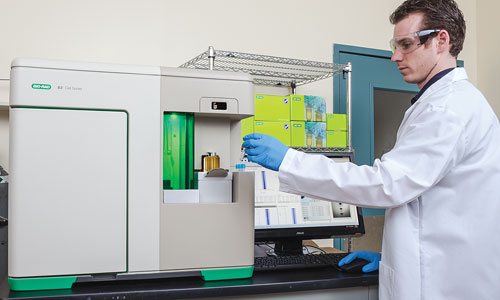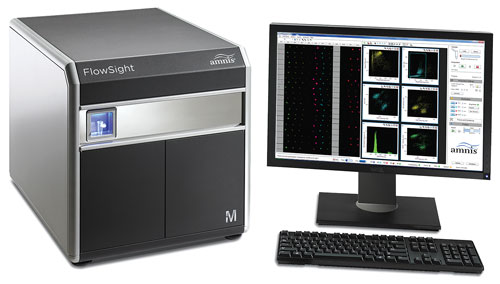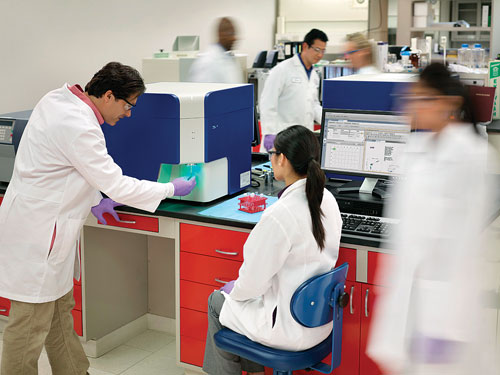March 15, 2013 (Vol. 33, No. 6)
Due to advances on many fronts, from microfluidics to software, flow cytometry is being simplified so that it can be more readily used by a wider range of scientists and clinicians without special expertise.
GEN recently spoke with technical representatives from a number of leading flow cytometry companies to get a sense of the latest instrument trends and to find out about the emergence of novel applications.
William Godfrey, Ph.D., manager of research application development, and James Tung, Ph.D., senior staff scientist, Beckman Coulter Life Sciences, both described a current move toward simpler, less expensive, benchtop instruments that offer robust and routine operation.
Simplification involves the creation of kits for common applications and the use of combinations of markers and fluors, algorithms, and software that take the judgment out of pattern recognition and make the interpretation of results less complex. In addition, companies are trying to provide detection of as many colors as possible in the simpler instruments. Dr. Tung noted that this goal is being helped by the arrival of new off-line analysis software to analyze the data, such as his company’s Kaluza® product.
New reagents are enhancing the ability to cover spectral overlap of multiple fluors. An example is Beckman Coulter’s VersaComp antibody capture bead kit, which can be used to set compensation for multicolor flow cytometry experiments, and will enable scientists to establish color compensation on research analyzers utilizing the same reagents found in their experiments.
Analyzing Microparticles
Dr. Tung pointed out that a particularly hot area involves work on flow cytometry analysis of microparticles that represent membrane fragments of dying cells or cancer cells. The company’s current flow cytometry offerings include the Gallios™, a mid-range benchtop instrument that provides acquisition of data from up to 10 colors. An option available for new 561 nm laser-ready Gallios systems provides researchers with the ability to analyze a greater range of fluorescent proteins and to more efficiently excite PE/PE tandems, according to Dr. Tung.
Yellow-green excitation provided at 561 nm produces less autofluorescence in cells, increasing the signal-to-noise ratio for PE and DsRed detection, added Dr. Godfrey. He sees applications coming down the road that include the use of flow cytometry to detect minimal residual disease and to sort cells that will ultimately be placed back into patients.
At Bio-Rad, Steve Kulisch serves as the manager of the cell biology business unit, which is responsible for the company’s S3™ cell sorter. Kulisch explained that when Bio-Rad surveyed the cell sorter space about four years ago, the company found the technology was used essentially only at core labs. This was primarily due to the expense and sophistication of the instruments needed for immunologists, whose applications had dominated cell sorting work in the past.
Kulisch added that as emerging sorting applications from a wider range of scientists have increased demand, these same core labs can now have wait times of up to three weeks. But “biology never waits,” continued Kulisch, and Bio-Rad viewed this situation as an opportunity to provide a high-performance, user-friendly cell sorter to handle less complex work. It also would be readily usable by scientists, who were not necessarily experts in flow cytometry.
The result: the S3, which is a benchtop cytometer that can be used to supplement larger instruments at core facilities, or as an instrument for the individual research lab. Kulisch said the S3 is much less expensive than previous cell sorters, more compact, and comes with sophisticated software that permits automatic instrument calibration and setup with minimal training.
The S3 is equipped with one or two lasers (488 nm, 561 nm, or 640 nm) and up to four fluorescent detectors plus scatter detectors utilizing established jet-in-air technology.
“It is ideal for high-speed enrichment of cell populations expressing fluorescent proteins, high-purity isolation of rare cells labeled with fluorescent markers, and the isolation of single cells for single-cell biology,” said Kulisch.

Cell sorting systems are used primarily in flow cytometry core facilities at academic, government, and industrial research institutions due to the size, high cost, and complexity of the operation and maintenance of flow cytometry instruments. Bio-Rad says the simplicity of operation and price point of the S3 cell sorter will make cell sorting more accessible.
Real-Time Images
At EMD Millipore, GEN spoke with both Bob Smith-McCollum, director of marketing for open cell analysis systems, including the Amnis® FlowSight® and ImageStreamX Mark II Imaging Flow Cytometers and the Guava EasyCyte™ Flow Cytometry System, and with Jason Whalley, director of marketing for cellular analysis. Smith-McCollum noted two important trends.
One was the provision of actual images of the cells as they move through the flow cell, which is offered by EMD Millipore’s use of CCD cameras in place of photomultiplier tubes (PMTs) in its Amnis imaging flow cytometers.
Another was the growing interest by a broad range of scientists in compact, “personal” flow cytometers that can detect one to six colors. Smith-McCollum pointed out that new applications are enabled by imaging flow cytometry on the Amnis instrument. These include observation and analysis of nuclear translocation, morphometric applications, quantitation and location of fluors, and the trafficking of markers through different cellular organelles.
Whalley emphasized the simplification and miniaturization offered by the company’s Muse™ cell analyzer. According to Whalley, Muse is an entry-level cell analyzer that characterizes cells, performs direct cell counts, and quantifies protein-expression levels.
“The platform enables researchers to have access to the analytical analysis of flow cytometry at their lab bench or in the cell culture hood without any prior experience of the technology. It is a true plug and play system,” he said.
Mike Olszowy, Ph.D., head of R&D for Life Technologies’ flow cytometry business, reported that at recent flow cytometry meetings he noticed a trend away from an engineering focus on lasers and PMTs to more of an emphasis on biological questions. He has also observed a major trend toward simpler, smaller, and less expensive instruments. This is leading, he said, to a “democratization of flow cytometry.”

EMD Millipore’s FlowSight is a compact 12-channel flow cytometer that it says provides high-end performance and images every cell. FlowSight can accommodate four lasers, an AutoSampler, and a Quantitative Imaging upgrade.
Life Technologies’ offerings include the Attune® acoustic focusing flow cytometer, which provides sample throughput at rates up to 1,000 µL/minute. Applications that can be carried out on this benchtop system include apoptosis analysis, cell-cycle analysis, phosphoprotein detection, immunophenotyping, rare event detection, intracellular marker detection, basic phenotyping (up to six colors), cell proliferation detection, green and red fluorescent protein detection, live/dead cell discrimination, and phagocytosis detection.
Sony Biotechnology’s vp for marketing and distributor operations, Lew McAllan, sees a number of novel applications coming to the fore with the new compact flow cytometry instruments. These fluorescent protein analysis, particularly simultaneous multifluorescent protein analysis and sorting, and stem cell analysis and sorting. Among Sony’s current product is the new SH800, a personal cell sorter that comes with up to four lasers and six-color detection.
The SH800 incorporates a microfluidic chip that replaces the conventional flow cell and nozzle design, with the goal being to ensure a clean system.
“The SH800 fully automates the setup for cell sorting,” explained McAllan. “In addition, a small size is achieved by taking advantage of the integrated laser technology and compact mechanical design technology cultivated in the Sony Blu-ray optical techniques.”
He noted that Sony also is developing a spectral analyzer, that by virtue of a 32-channel PMT and deconvolution algorithms in software, will allow simultaneous analysis of overlapping fluorochromes, providing at least 14-color analysis for two standard lasers.
Smaller Can Be Better
J. Clark Mason, Ph.D., senior director of global marketing for flow cytometry at BD Biosciences, emphasized that BD always focuses on developing a complete system when it is updating its flow cytometry technology. He said that lasers packing the same power have been made smaller allowing for more compact instruments with a higher performance/footprint. These instruments can “punch beyond their weight,” he said.
In addition, there has been a revolution in the power of the fluorescent dyes that can be used. Last August BD acquired the Sirigen Group, including its polymer dye products. According to Dr. Mason these are 10–20X brighter than conventional fluorescent dyes and have much reduced complication of spectral overlap.
“Such dyes add to the power of the new technology platforms, providing the capacity for increased multiplexing and permitting identification of dimly staining populations that were previously challenging to resolve,” he said, adding that the development of more sophisticated software permits researchers to carry out in-depth analysis on the smaller, benchtop platforms.
Dr. Mason said that recent advances in personal flow cytometry are contributing to the revolution in the genomics arena where the technology is enabling high-accuracy, high-purity single-cell isolation for analysis of single-cell gene expression and next-generation DNA sequencing. According to Dr. Mason, BD recently launched a benchtop cell sorter—FACSJazz™—that makes commonly used cell-sorting applications accessible to researchers with limited flow cytometry experience.

BD Biosciences’ recent advances in personal flow cytometry are enabling high-accuracy, high-purity single-cell isolation for analysis of gene expression and next-generation DNA sequencing.
One Technology Led to Another
Miltenyi Biotec’s involvement in flow cytometry dates back some 20 years to the company’s origin specializing in magnetic cell separation (MACS®), explained Shane Oram, Ph.D., global marketing manager, flow cytometry. The technology was used to evaluate the quality of separation that had been achieved via the magnetic technique.
Dissatisfaction with the instruments available at the time led Miltenyi to develop its own line of flow cytometry instruments.
“Today’s benchtop instruments do virtually everything for the user who simply needs to push a few buttons and walk away,” he said.
With its power to analyze hundreds of thousands of cells in minutes, flow cytometry instruments can replace microscopes for many applications, added Martin Büscher, Ph.D., head of biophysics at Miltenyi. The systems are now used in stem cell research, organelle analysis, circulating tumor cell identification, water monitoring, the checking of lipid content of biofuels, and many other areas, he pointed out.
Dr. Oram described Miltenyi Biotec’s latest flow cytometer, the MACSQuant® VYB, as a three-laser, eight-color benchtop analyzer that has a pipetting robot on the front end and also offers magnetic cell separation to pre-enrich samples when looking for rare events.
According to Dr. Büscher, Miltenyi Biotec, as well as some other companies, now offer calibration particles that can be used by researchers to ensure consistent and comparable results from day-to-day and from lab-to-lab.
Suzanne Hancock, project manager in the R&D group for research and applied markets at GE Healthcare Life Sciences, said that the company had recently conducted an extensive customer survey of a wide range of scientists to assess their flow cytometry needs. The results indicated that the scientists were highly interested in simplification of the technology and in hassle-free systems that would allow them to do every-day tasks that might normally require the use of three to four different instruments and would pull all these tasks together on one platform.
The scientists also were looking for increased efficiency from both research acceleration and manufacturing productivity standpoints. They want systems with greater accessibility that could be used in the individual lab to provide immediate answers to typical questions such as the health of the cells, number of cells, and phenotypes, and thus allow the researchers to move on to the next experiment, rather than having to wait for an answer to come back from the core lab.
In addition, the researchers have a need for systems that can efficiently handle small volumes of material as they often did not have the luxury of having significant sample quantities. Systems that would permit them to implement their own applications as well as providing preset standard applications were also on the researchers’ list of needs.
In response, Hancock explained that GE Healthcare developed a new benchtop platform, the Cytell™ Image Cytometer, which was introduced to the marketplace last year. This instrument is actually not a flow cytometer, but performs many of the same functions and provides an actual image of the cells. Applications include analysis of physical characteristics, cell counting and viability, apoptosis analysis, assessment of cell health, and phenotypic analysis of fluorescent proteins and cell surface markers.
The instrument is intended to supplement standard flow cytometers. Numerous applications are preconfigured on the system and simply require the pushing of a button to implement, according to Hancock.



